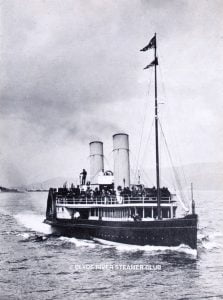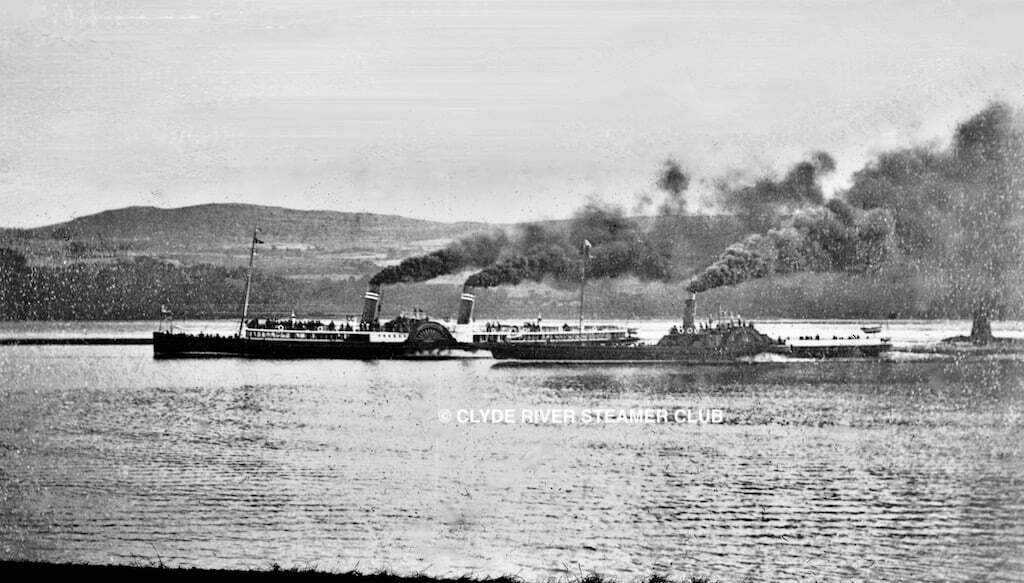
Lord of the Isles of 1877 overtaking Marquis of Bute in the River Clyde: the new breed of tourist steamer was typically bigger, faster and more opulent than its traditional ‘doon the watter’ counterpart, and attracted a more upmarket clientele
In the latest instalment of his comparative study of the writings of Captain James Williamson (Clyde Passenger Steamers from 1812 to 1901) and Andrew McQueen (Clyde River-Steamers of the Last Fifty Years), Graeme Hogg examines their treatment of three notable ships which appeared between 1877 and 1880.
Towards the end of the 1870s there was a significant development in the evolution of the Clyde steamers. By that time, in addition to the main services to Dunoon, Rothesay, Largs, Millport, Ayr and elsewhere, passengers were being offered excursions to various parts of the Firth such as Arran, the Kyles of Bute and the lochs of the Clyde. However, the ships providing these excursions were little different to those on the regular services and offered limited facilities by way of shelter and catering for what could be lengthy cruises.
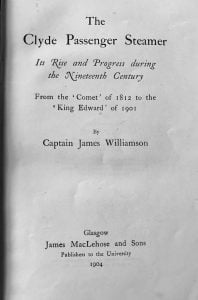
Frontispiece of Captain James Williamson’s book, published in 1904 and long regarded as a Bible of 19th century steamer history
The exception was David Hutcheson’s Iona of 1864, which maintained the Clyde leg of the ‘Royal Route’ from Glasgow to Ardrishaig daily except Sundays each summer. She was catering for a more up-market clientele as she would convey wealthy landowners, their households and guests on the first leg of their journey to their estates in the west highlands. Accordingly, she was equipped with extensive deck saloons fore and aft and catering facilities of a high standard.
Between 1877 and 1880, three ships were to appear which would forever change the public’s expectations of the ‘tourist steamer’ and establish a standard for virtually all the ships built for Clyde service until the First World War. We are lucky to have first-hand descriptions of these vessels from two authors, James Williamson (1852-1919) and Andrew McQueen (1868-1933), who witnessed their arrival and, in one case, was instrumental in having the ship built. Both wrote about them at some length.
The first of the new ships was Lord of the Isles. She was built by D. & W. Henderson at Meadowside for a new concern, the Glasgow and Inveraray Steamboat Company, and for a new daily excursion, initially from Greenock, but later Glasgow, via Dunoon, Wemyss Bay, Rothesay and the Kyles to Inveraray and back. She was, according to James Williamson (JW), “the first formidable rival to the Iona and broke up the monopoly of tourist and excursion traffic so long held by David Hutchison (sic) & Co”. He declared her advent “the chief sensation of the year” and described her as “an ideal saloon excursion steamer. Many improvements and innovations were introduced in her equipment to add to the comfort of the passengers”.
At 246 feet Lord of the Isles was some nine feet shorter than Iona, but similar in appearance and layout, with funnels fore and aft of the paddles and large saloons with alleyways around them. Andrew McQueen (AM) was even more smitten, describing her as “one of the most beautiful paddle steamers ever built; she sat like a duck in the water and her whole design was a harmony without a single jarring note”. He also detailed some of the innovations, which JW had alluded to in his description of how “the scribes waxed enthusiastic over her steam-steering gear, her post office on board, her superior lavatory arrangements and her diagonal oscillating engine ‘of great power’.”

The 1877 Lord of the Isles was a success from the outset: she is pictured (right) at Rothesay c1884 with Athole in the foreground and Bonnie Doon behind
The first ‘Lord’ was a success from the outset. She was managed by M. T. Clark, who also managed the ships of the Lochgoil fleet, and she shared their livery of black hull and paddle boxes, white deck saloons and red funnels with a black top separated by two white bands with a black band between. In addition to the daily cruise offering, the Loch Eck Tour was also developed. This had been devised as long ago as 1828 by David Napier but, in its latest guise, enabled tourists to sail initially to Kilmun (or Dunoon) in the morning by other steamers and continue by coach to Loch Eck, before proceeding to sail its length on the tiny Fairy Queen. A second coach would convey them to Strachur on Loch Fyne, where they would join Lord of the Isles for Inveraray and the return trip to Greenock. A version of the route could also be followed in reverse.
Such was her success that she was replaced after the 1890 season by a more modern Lord of the Isles and began a second career on the Thames. She received telescopic funnels to permit her to pass under some of the bridges on the river. These ruined her fine looks. She raised the standards of her new trade too, but after a few years returned to the Clyde as Lady of the Isles for the Sunday trade. She was a mere shadow of her former self and went to the breakers in 1904, after a relatively short career.
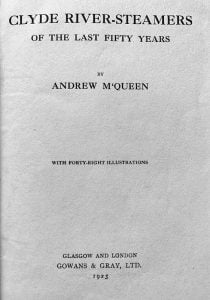
Frontispiece of Andrew McQueen’s book. He was elected Honorary President when CRSC was founded in 1932
David MacBrayne effectively took over David Hutcheson & Co. and renamed the company in his own name in 1879. Stung by the success of the 1877 Lord of the Isles, he was determined to build a ship to eclipse her and re-establish his company’s pre-eminence on the Loch Fyne trade. The order was given to J. & G. Thomson of Clydebank, which produced Columba in 1878. David MacBrayne is said to have taken a very active part in her development and construction, and can be credited with most of her design innovations. As McQueen notes, “the bold course was adopted of constructing her of steel, which was then in the experimental stage”.
Williamson goes into further detail: “Most notable of the improvements were the deck saloons, which were built the full width of the vessel and throughout two-thirds of her entire length. Internally she was well fitted up. Her upper saloon had double settees placed thwartwise on each side with a passage along the centre, while her lower, or dining saloon, was handsomely decorated and panelled, and had accommodation for the dining of 130 passengers. Provision was made for the expeditious working of the vessel at wharves and piers by the installation of warping sheaves fore and aft by Muir & Caldwell, an entirely new feature on board a Clyde steamer. She was fitted with steam steering gear, also by Muir & Caldwell and with Chadburn’s telegraphs between bridge and engine room, which has now become recognised as an essential part of the regular outfit of steamers.”
McQueen tended to focus more on internal appointments, but even he failed to mention the post office or barber shop on board, the latter being another innovation. Neither commented, favourably or otherwise, on her appearance, beyond describing her as “this largest and finest of the river steamers” (JW) and saying “she was and is, a very notable steamer” (AM).
Columba was 301 feet in length, making her, by some margin, the longest ship on the Firth. While her tonnage was exceeded by several ships in later years, her length was not exceeded until the appearance of Caledonian Isles 113 years later.
David MacBrayne’s ambition was rewarded as Columba settled into the Glasgow-Ardrishaig summer service, outclassing Lord of the Isles and becoming one of the most famous ships in the world in the period to the First World War. She remained on the service for 57 years and there was huge sadness when she and Iona were finally withdrawn after the 1935 season.
The third ship of the trio was the brainchild of Williamson himself and, as might be expected, he gives her extensive and very favourable coverage. The ship in question was Ivanhoe, the “teetotal boat” of 1880, another product of D. & W. Henderson.
She was an experimental venture. “The object aimed at,” wrote Williamson, “was to provide an all-day sail without the liability of witnessing the disorderly scenes too frequently met with on board the river steamers, and to exclude persons unable to enjoy a holiday without getting drunk, creating disturbance and causing discomfort to their fellow passengers”. A consortium of shipowners and others formed the Frith of Clyde Steam Packet Company to acquire and operate the ship. JW was a member of the consortium and was appointed its general manager, secretary and the master of the ship. “In point of finish and equipment [she] was second to no other steamer. As regards order and discipline, it was universally conceded that the Ivanhoe closely resembled a private yacht”.
AM was slightly less effusive in his comments. “In design both of hull and machinery she closely resembled the Lord of the Isles, although smaller, but she never conveyed quite the same impression of buoyancy”. He did recognise the high standards of upkeep and discipline, confirming her resemblance to a private yacht. Her livery reinforced that impression, comprising navy blue hull with black paddle boxes, pink deck saloons, lined with pale blue, and yellow funnels, a scheme adopted by the Caledonian Steam Packet Company (CSP) a few years later, apart from its white paddle boxes.
She was a commercial success, contrary to the expectations of many at the time who predicted a “teetotal failure”. She did attract a more sedate group of patrons keen to avoid the rowdier scenes witnessed elsewhere. JW lamented that the support from the temperance movement was not as robust as might have been anticipated until later in her career, while AM pointed out that “the vessel’s one drawback could be discounted by a little forethought before embarking and the “Ivanhoe flask” found a ready sale in Glasgow”.
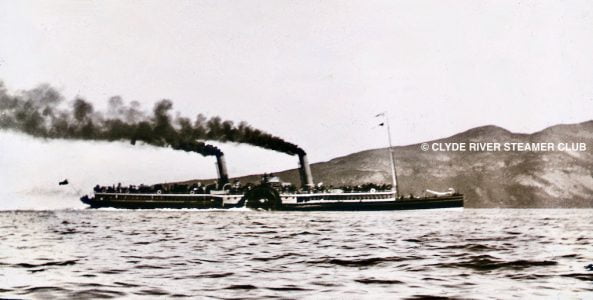
Ivanhoe in Lamlash Bay. She was popular on the Arran via the Kyles route, cruised to Ailsa Craig and gave a boost to evening cruises and illuminations specials. Having lost her teetotal status in the late 1890s, she continued under different owners until 1919
The route chosen for the new steamer was inspired and would become a mainstay of Clyde cruising until the 1970s. Recognising a steady decline in traffic, Glasgow was excluded from the itinerary. Ivanhoe departed from Helensburgh, calling at Princes Pier, Dunoon, Wemyss Bay, where most Glasgow passengers joined, Rothesay, through the Kyles of Bute to Arran, with calls at Corrie, Brodick, Lamlash, Kings Cross and Whiting Bay. The return was via Garroch Head instead of the Kyles. On Saturdays a cruise to Ailsa Craig would be given.
The second innovation in operational terms was the introduction of evening cruises which, while not wholly original, helped to establish the concept and led to many imitators, including Lord of the Isles.
In particular, illuminations cruises, where passengers and locals alike would be entertained by fireworks displays, were initiated by Ivanhoe, first in the Gareloch before moving on to Coulport and eventually being taken up by the councils in Dunoon and Rothesay as additional visitor attractions. By the early years of the 20th century up to two dozen steamers, from all parts of the Firth, might converge on the relevant venue for the display.
Ivanhoe continued as the teetotal boat for 17 years, including a brief spell on the Manchester Ship Canal. On her return to the Clyde in 1898, she was acquired by the CSP whereupon bars were installed. She was used for both cruising and railway connection work for another 15 years before ultimately becoming part of the fleet of JW’s brother John, on the up-river traffic. During World War I she was on charter to the CSP for railway connection work until 1919, after which she was laid up and finally scrapped in 1920.
In their different ways these three steamers played a major role in raising standards on the Clyde. They were also very attractive ships, initiating many of the design features which graced the various fleets in the years to come.
All images on the CRSC website are protected by copyright law. Do not reproduce them on Facebook, Pinterest or any other public platform.

Lord of the Isles arriving at Greenock: according to Andrew McQueen, she was ‘one of the most beautiful paddle steamers ever built’

The first ‘Lord’ arriving at Rothesay c1884 (with Benmore on the left). She was so successful that she was replaced in 1891 by a bigger boat of the same name, and sold to the Thames. Her late career back on the Clyde as Lady of the Isles was unsuccessful and she was broken up in 1904
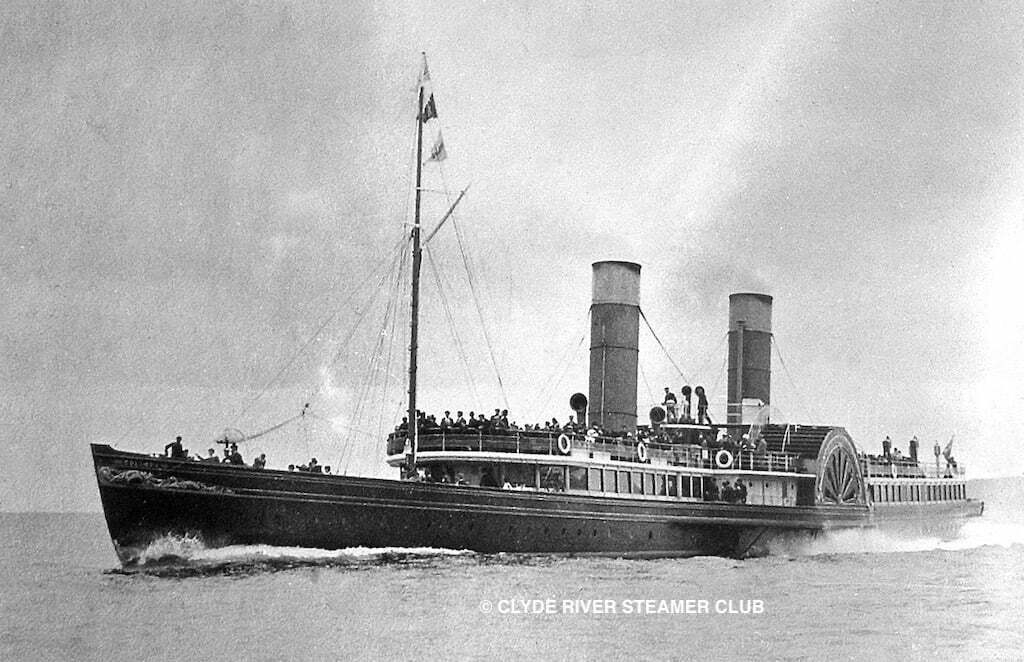
David MacBrayne’s Columba c1902. Thirled to the Glasgow-Ardrishaig mail service for three and a half months every summer, she lasted 57 years and became world famous. James Williamson described her as ‘the largest and finest of the river steamers’.

Ivanhoe (right) sidles into the east end berth at Rothesay c1888, with Benmore in the inner harbour. The clock tower reads 7.20 in the morning, and the puffer occupying the centre of the pier appears oblivious to the impending influx of commuter and tourist steamers

Tourist steamers at Rothesay c1904: Columba (foreground) and the second Lord of the Isles are leaving simultaneously for the Kyles of Bute and beyond, with a thrilling race in store. At the far end, the railway steamer Duchess of Montrose awaits her next commuter run to one of the Caley railheads
Read more steamer stories on the CRSC website by clicking on News & Reports.
SEE ALSO:
Published on 27 September 2021












